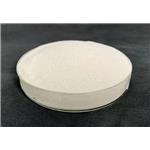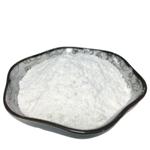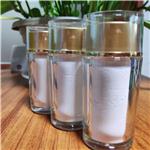- Cladribine
-

- $0.00 / 1kg
-
2024-04-15
- CAS:4291-63-8
- Min. Order: 1kg
- Purity: 99%
- Supply Ability: 20tons
- Cladribine
-

- $0.00 / 25KG
-
2023-10-16
- CAS:4291-63-8
- Min. Order: 1KG
- Purity: 99%
- Supply Ability: 50000KG/month
- Cladribine
-

- $0.00 / 1KG
-
2023-09-06
- CAS:4291-63-8
- Min. Order: 1KG
- Purity: 99%
- Supply Ability: 500000kg
|
| | Cladribine Chemical Properties |
| Melting point | 181-185 °C(lit.) | | alpha | D25 -18.8° (c = 1 in DMF) | | Boiling point | 547.6±60.0 °C(Predicted) | | density | 2.03±0.1 g/cm3(Predicted) | | storage temp. | -20°C | | solubility | Slightly soluble in water, soluble in dimethyl sulfoxide, slightly soluble in methanol, practically insoluble in acetonitrile. It shows polymorphism (5.9). | | pka | 13.75±0.60(Predicted) | | form | White solid | | color | White to Pale Yellow | | λmax | 265nm(EtOH aq.)(lit.) | | Merck | 14,2337 | | Stability: | Store in Freezer | | InChIKey | PTOAARAWEBMLNO-HSUXUTPPSA-N | | CAS DataBase Reference | 4291-63-8(CAS DataBase Reference) |
| | Cladribine Usage And Synthesis |
| Description | Cladribine (2-chloro-2′-deoxyadenosine) is an adenosine deaminase-resistant analogue of deoxyadenosine. The drug has a broad range of in vitro activity against both lymphoid and myeloid neoplasms [mean IC50values (drug concentration required to inhibit cell growth by 50% of control): 20 to 87 nmol/L]. But it possesses little activity against multiple myeloma specimens and many solid tumor cell lines. Monocytes are highly sensitive to cladribine in vitro. Cladribine demonstrates activity against both dividing and nondividing cells and this activity distinguishes it from many other agents. It has activity in murine models of leukaemia. Cladribine is used to treat chronic progressive multiple sclerosis, hairy cell leukemia, systemic mastocytosis, and histiocytosis (including Erdheim–Chester disease and Langerhans cell histiocytosis).
After a 2-hour intravenous infusion of cladribine 0.14 mg/kg/day, the mean maximum plasma drug concentration was 198 nmol/L. Intracellular concentrations of phosphorylated cladribine derivatives exceed plasma concentrations 128- to 375-fold. Cladribine penetrates into the CSF. The terminal elimination half-life (6.7 hours) is long, which suggests that the drug may be administered intermittently without loss of efficacy. The volume of distribution of cladribine is 9.2 L/kg.
| | References | [1] J.C Sipe, J. S Romine, R. McMillan, E. Beutler, J. C. Sipe, J. S. Romine, J. Zyroff (1994) Cladribine in treatment of chronic progressive multiple sclerosis, 344, 9-13
[2] Alan Saven, Carol Burian (1999) Cladribine Activity in Adult Langerhans-Cell Histiocytosis, 93, 4125-4130
[3] https://en.wikipedia.org/wiki/Cladribine
[4] Harriet M. Bryson, Eugene M. Sorkin (1993) Cladribine: A Review of its pharmacodynamic and pharmacokinetic properties and therapeutic potential in haematological malignancies, 46, 872-894
| | Description | Cladribine, an adenosine deaminase inhibitor, was introduced in the United States as a
single intravenous treatment for hairy cell leukemia. The incorporation of a chlorine atom at
the 2-position of deoxyadenosine renders cladribine more resistant to enzymatic attack by
adenosine deaminase, resulting in a more prolonged cytotoxic effect. Cladribine efficiently
crosses lymphocyte and monocyte cell membranes and is metabolized in cells to the
biologically active triphosphate, which inhibits DNA synthesis. While most antineoplastic
drugs are active primarily against dividing cells, cladribine destroys both resting and
proliferating cells. Its potential uses in the treatment of autoimmune hemolytic anemia,
multiple sclerosis, chronic lymphocytic leukemia and various lymphomas have also been
evaluated. | | Chemical Properties | White Crystalline Solid | | Originator | Johnson & Johnson (U.S.A.) | | Uses | 2-Chloro-2′-deoxyadenosine (2-CdA) is a chlorinated purine nucleoside with activity against lymphoproliferative disorders, such as hairy cell leukemia (HCL) and multiple myeloma (MM). 2-CdA resists ADA degradation and is phosphorylated to CdATP in lymphocytes. CdATP incorporation into DNA induces strand breaks and the activation of apoptosis. 2-CdA may also be used in studies involving the inhibition of DNA polymerase(s).
Cladribiane, like fludarabine, is a prodrug that is must be phosphorylated intracellularly to the monophosphate by the nuclear/cytosol enzyme deoxycytidine kinase (dCK) and possibly by the mitochondrial enzyme deoxyguanosine kinase (dGK). | | Uses | It is a substituted purine nucleoside with antileukemic activity | | Indications | Cladribine (Leustatin) is a synthetic purine nucleoside
that is converted to an active cytotoxic metabolite by
the enzyme deoxycytidine kinase. Like the other purine
antimetabolites, it is relatively selective for both normal
and malignant lymphoid cells and kills resting as well as
dividing cells by mechanisms that are not completely
understood.
The drug is highly active against hairy cell leukemia,
producing complete remissions in more than 60% of patients
treated with a single 7-day course. Activity has
also been noted in other low-grade lymphoid malignancies.
The major side effect is myelosuppression. | | Definition | ChEBI: 2'-Deoxyadenosine in which the hydrogen at position 2 on the purine ring has been substituted by chlorine. It inhibits the synthesis and repair of DNA, particularly in lymphocytes and monocytes, and is used as an antimetabolite antineoplastic drug for the
treatment of lymphoid malignancies including hairy-cell leukaemia and chronic lymphocytic leukaemia. | | Manufacturing Process | Manufacturing process for Cladribine includes these steps as follows: Preparation of 2',3',5'-O-triacetyl guanosine;Preparation of 9-(2',3',5'-O-triacetyl-β-D-ribofuranosyl)-2-amino-6-
chloropurine;Preparation of 9-(2',3',5'-O-triacetyl-β-D-ribofuranosyl)-2,6-dichloropurine;Preparation of 2-chloroadenosine;Preparation of 2-chloro-(3',5'-O-tetraisopropyldisiloxyl)adenosine; Preparation of 2-chloro-2'-O-phenoxythiocarbonyl-(3',5'-O-tetraisopropyl�disiloxyl)adenosine; Preparation of 2-chloro-2'-deoxy-(3',5'-O-tetraisopropyldisiloxyl)adenosine; Preparation of 2-chloro-2'-deoxy-adenosine. | | Brand name | Leustatin (Ortho Biotech). | | Therapeutic Function | Cytostatic | | General Description | The drug is available in a 10-mg or 10-mL single-use vialfor IV use. Cladribine is used for chronic lymphocyticleukemia, hairy cell leukemia, and non-Hodgkin’s lymphoma.The mechanism of action of this purine deoxyadenosineanalog involves incorporation into DNA resultingin inhibition of DNA chain extension and inhibitionof DNA synthesis and function. This incorporation intoDNA occurs via the triphosphate metabolite active species.The 2-chloro group on the adenine ring produces resistanceto breakdown by adenosine deaminase. Resistance to the anticancereffects can occur because of decreased expressionof the activating enzyme or overexpression of the catabolicenzymes. Oral bioavailability is variable and averages about50%. The drug crosses the blood-brain barrier; however,CSF concentrations reach only 25% of those in plasma. Thedrug is selectively activated inside the cell, and intracellularconcentrations of phosphorylated metabolites exceed thosein plasma. Toxicities include myelosuppression, neutropenia,immunosuppression, fever, nausea, and vomiting. | | Biochem/physiol Actions | Deoxyadenosine analog resistant to adenosine deaminase; antileukemic with immunosuppressive activity | | Clinical Use | Antineoplastic agent:
Hairy cell leukaemia (HCL)
Chronic lymphocytic leukaemia (CLL) in patients
who have failed to respond to standard regimens. | | Drug interactions | Potentially hazardous interactions with other drugs
Antipsychotics: avoid with clozapine - increased risk
of agranulocytosis.
Antivirals: avoid with lamivudine.
Caution when administering with any other
immunosuppressive or myelosuppressive therapy | | Metabolism | Cladribine is extensively distributed and penetrates into
the CNS. Cladribine is phosphorylated within cells by
deoxycytidine kinase to form 2-chlorodeoxyadenosine-
5′-monophosphate which is further phosphorylated to
the diphosphate by nucleoside monophosphate kinase
and to the active metabolite 2-chlorodeoxyadenosine-5′-
triphosphate (CdATP) by nucleoside diphosphate kinase.
CdATP inhibits DNA synthesis and repair, particularly
in lymphocytes and monocytes
There is little information available on the route of
excretion of cladribine in man. An average of 18% of
the administered dose has been reported to be excreted
in urine of patients with solid tumours during a 5-day
continuous intravenous infusion. | | storage | Store at +4°C |
| | Cladribine Preparation Products And Raw materials |
|